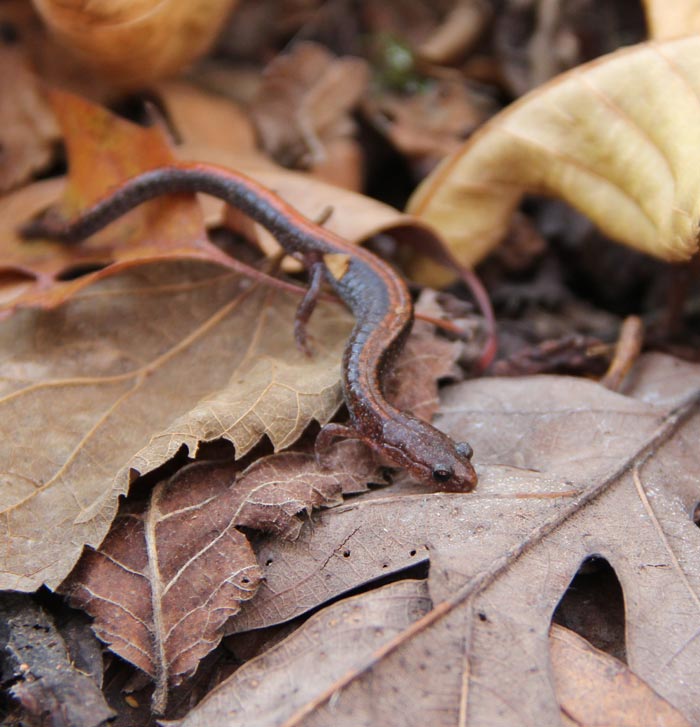Salamanders Are a More Abundant Food Source in Forest Ecosystems Than Previously Thought

Southern Redback Salamander Semlitsch’s study measured the population density and biomass of the Southern Redback Salamander in the Ozark Highlands in Missouri. Credit: Katie O’Donnell
In the 1970s, ecologists published results from one of the first whole-forest ecosystem studies ever conducted in Hubbard Brook, New Hampshire. In the paper, scientists reported that salamanders represent one of the largest sources of biomass, or food, of all vertebrates in the forest landscape.
Now, using new sampling and statistical techniques not available during the past study, researchers at the University of Missouri have estimated that the population of salamanders in forested regions of the Missouri Ozarks are 2-4 times higher than originally thought, and in other regions of the eastern U.S. may be on average 10 times higher. Scientists believe that acknowledging salamanders as one of the main food sources in forest ecosystems could help drive conservation efforts and forest management.
“Our lab works to identify salamanders as an influential part of the forest ecosystem and food chain,” said Ray Semlitsch, Curators Professor of Biological Sciences in the College of Arts and Science at MU.
“Using the latest research methods, we calculated the population size of Southern Redback Salamanders in Ozark Forests and their value as a food source. We found that 1.88 billion salamanders inhabit one district of the Mark Twain National Forest alone, which is roughly 1,400 metric tons of biomass. For comparison, that’s equivalent to the biomass found in most whitetail deer in that region!”
There are two methods for estimating abundance. One is to simply count salamanders and plot the numbers on a grid representing the forest landscape. That is how the estimates were calculated in the 1970s.
However, Semlitsch’s group, armed with the knowledge that the majority of salamanders are underground at any given time, captured animals on the surface during intensive repeated surveys over two years and used statistical modeling to produce a more thorough accounting of variation in salamander population density.
“Our abundance models also take into account environmental factors,” Semlitsch said. “Factors such as date of collection, time since last rainfall, slope of the terrain and forest canopy cover are plugged into the model to help predict variation in the surface population over time; that’s what makes our model so powerful. The hidden biodiversity of amphibians is something we don’t generally consider; we forget that salamanders are nocturnal and mostly unobserved. Therefore, I think most will be amazed at the quantities of food out there that we just don’t see.”
Semlitsch believes that future research should consider the importance of amphibians to ecosystem processes such as soil enrichment. Future forest management techniques and protection of salamanders are important to healthy forest ecosystems and should be considered in all forest management decisions, Semlitsch said.
The study, “Abundance, biomass production, nutrient content, and the possible role of terrestrial salamanders in Missouri Ozark forest ecosystems,” was published in the Canadian Journal of Zoology, and was funded in part by the U.S. Forest Service cooperative Agreement with support from the Missouri Department of Conservation. Katie O’Donnell, a doctoral student in the Division of Biological Sciences at MU, and Frank Thompson, director of the Forest Service Experimental Station at MU, co-authored the paper.
-30-
Editor’s Note: To read an extended interview with Semlitsch about this study, please visit: “Semlitsch talks about his study on salamander abundance.”
Media Contact
All latest news from the category: Ecology, The Environment and Conservation
This complex theme deals primarily with interactions between organisms and the environmental factors that impact them, but to a greater extent between individual inanimate environmental factors.
innovations-report offers informative reports and articles on topics such as climate protection, landscape conservation, ecological systems, wildlife and nature parks and ecosystem efficiency and balance.
Newest articles

Study sheds light on cancer cell ‘tug-of-war’
How cancer cells tug against each other determines whether they can migrate elsewhere in the body. Understanding how cancerous cells spread from a primary tumor is important for any number…

Latest generation of self-dissolving stents
Magnesium implants support coronary arteries and keep them open. Constricted coronary arteries harbor dangers: Because the heart is not supplied with blood properly, this can lead to pain, cardiac arrhythmia,…

Stopping blood cancer
The MHH joint project TARGET-MPN is investigating why the disease persists and progresses in malignant bone marrow diseases from the group of myeloproliferative neoplasms despite targeted treatment. Haematopoietic stem cells…





















